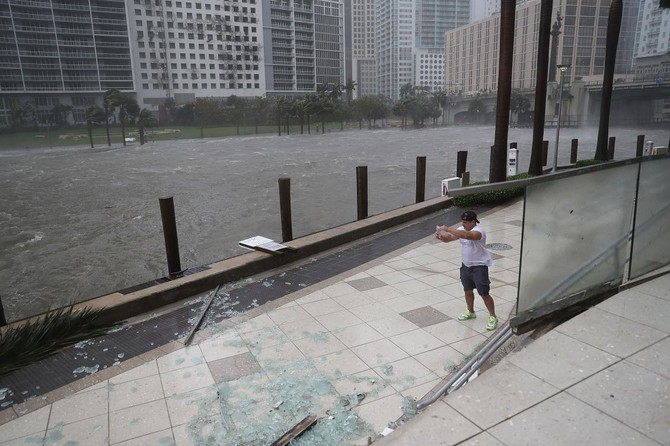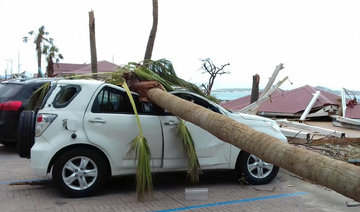TAMPA, Florida,/MIAMI: Hurricane Irma took aim at heavily populated areas of central Florida on Monday as it carved a path of destruction through the state with high winds and storm surges that left millions without power, ripped roofs off homes and flooded city streets.
Irma, once ranked as one of the most powerful hurricanes recorded in the Atlantic, came ashore in Florida on Sunday and battered towns as it worked its way up the state.
It weakened to a Category 1 hurricane, carrying maximum sustained winds of about 85 miles per hour (135 km per hour) by 2 a.m. ET (0600 GMT) on Monday, the National Hurricane Center said. The hurricane was churning northwest in the center of the state near the Tampa and Orlando metro areas.
Many areas on both the state’s east and west coasts remained vulnerable to storm surges, when hurricanes push ocean water dangerously over normal levels.
Florida Director of Emergency Management Bryan Koon said officials would wait until first light on Monday to begin rescue efforts and assess damage, adding he did not have yet any numbers on fatalities statewide, the Miami Herald reported.
On Sunday, Irma claimed its first US fatality — a man found dead in a pickup truck that had crashed into a tree in high winds in the town of Marathon, in the Florida Keys, local officials said.
The storm killed at least 28 people as it raged westward through the Caribbean en route to Florida, devastating several small islands, and grazing Puerto Rico, the Dominican Republic and Haiti before pummeling parts of Cuba’s north coast with 36-foot-tall (11-meter) waves.
Irma was ranked a Category 5, the rare top end of the scale of hurricane intensity, for days, and carried maximum sustained winds of up to 185 mph (295 kph) when it crashed into Barbuda island on Wednesday. Its ferocity as it bore down on hurricane-prone Florida prompted one of the largest evacuations in US history.
Some 6.5 million people, about a third of the state’s population, had been ordered to evacuate southern Florida. Residents fled to shelters, hotels or relatives in safer areas.
Many of the evacuation orders extended until at least Monday due in part to flooding, massive power outages and downed electric lines, leaving residents unable to return to their homes to survey any damage.
Jonathan Brubaker, 51, waited out the storm bunkered in a recently constructed house in Bradenton, on the state’s west coast south of Tampa, with hurricane shutters drawn, flashlights and candles ready. As a radar app on his phone showed Irma passing by, he had seen little more than gusty winds. He still had power.
“I feel like we kind of dodged bullet on this one,” he said, adding that he would wait until Monday morning before trying to sleep. “And then, I think we’re OK, knock on wood.”
TV news video of damage in Naples, a city on the Gulf coast about 125 miles (200 km) northwest of Miami, showed buildings ripped apart by hurricane winds and streets flooded by rain and storm surges.
MILLIONS WITHOUT POWER
High winds snapped power lines and left about 4 million Florida homes and businesses without power in the state, whose economy represents about 5 percent of US gross domestic product.
Miami International Airport, one of the busiest in the country, halted passenger flights through at least Monday. The airport said in a Twitter post that after assessing damage, it would determine if flights could resume on Tuesday.
Irma was forecast to continue churning northward along Florida’s Gulf Coast during Monday morning, further weakening along the way before diminishing to tropical-storm status over far northern Florida or southern Georgia later in the day.
It could dump as much as 25 inches (63.5 cm) of rain in parts of Florida and as much as 16 inches in parts of Georgia, prompting flash flood and mudslide warnings, the National Hurricane Center said.
The storm’s westward tilt to Florida’s Gulf Coast spared the densely populated Miami area the brunt of its wrath, although the wide reach of the hurricane meant the state’s biggest city was still battered.
SKYSCRAPERS SWAY IN LASHING WINDS
Five tornados were reported in Florida on Sunday, causing damage to several structures but there were no indications of anyone being seriously injured, the National Weather Service said.
Along with hurricane warnings and watches in Florida, the weather service placed tropical storm warnings for large parts of Alabama, Georgia and South Carolina.
Miami apartment towers swayed in the high winds on Sunday, three construction cranes were toppled, and small white-capped waves could be seen in flooded streets between Miami office towers.
Waves poured over a Miami seawall, flooding streets waist-deep in places around Brickell Avenue, which runs a couple of blocks from the waterfront through the financial district and past foreign consulates. High-rise apartment buildings were left standing like islands in the flood.
“We feel the building swaying all the time,” restaurant owner Deme Lomas said in a phone interview from his 35th-floor apartment. “It’s like being on a ship.”
Police in Miami-Dade County said they had made 29 arrests for looting and burglary. “We’re on patrol and won’t tolerate criminal activity as our community recovers from Hurricane Irma,” police said in a Twitter post.
The storm and evacuation orders caused major disruption to transportation in the state that is a major tourist hub. Thousands of flights were canceled.
Irma was expected to cause billions of dollars in damage to the third-most-populous US state.
However European shares rose on Monday in early deals, led higher by insurers as the weakening of Irma raised expectations that costs for the industry might be lower than initially feared.
Irma hit just days after the Houston area was deluged by unprecedented flooding from Hurricane Harvey, which dumped more than 50 inches (127 cm) of rain in parts of Texas.
Harvey killed at least 60 people and caused an estimated $180 billion in property damage.
US President Donald Trump, acting at the governor’s request, approved a major disaster declaration for Florida on Sunday, freeing up emergency federal aid in response to Irma, which he called “some big monster.”
Irma churns through central Florida, leaves trail of destruction
Irma churns through central Florida, leaves trail of destruction

Archbishop of York says he was ‘intimidated’ by Israeli militias during West Bank visit

- “We were … intimidated by Israeli militias who told us that we couldn’t visit Palestinian families in the occupied West Bank,” the archbishop said
LONDON: The Archbishop of York has revealed that he felt “intimidated” by Israeli militias during a visit to the Holy Land this year.
“We were stopped at various checkpoints and intimidated by Israeli militias who told us that we couldn’t visit Palestinian families in the occupied West Bank,” the Rev. Stephen Cottrell told his Christmas Day congregation at York Minster.
The archbishop added: “We have become — and really, I can think of no other way of putting it — we have become fearful of each other, and especially fearful of strangers, or just people who aren’t quite like us.
“We don’t seem to be able to see ourselves in them, and therefore we spurn our common humanity.”
He recounted how YMCA charity representatives in Bethlehem, who work with persecuted Palestinian communities in the West Bank, gave him an olive wood Nativity scene carving.
The carving depicted a “large gray wall” blocking the three kings from getting to the stable to see Mary, Joseph and Jesus, he said.
He said it was sobering for him to see the wall in real life during his visit.
He continued: “But this Christmas morning here in York, as well as thinking about the walls that divide and separate the Holy Land, I’m also thinking of all the walls and barriers we erect across the whole of the world and, perhaps most alarming, the ones we build around ourselves, the ones we construct in our hearts and minds, and of how our fearful shielding of ourselves from strangers — the strangers we encounter in the homeless on our streets, refugees seeking asylum, young people starved of opportunity and growing up without hope for the future — means that we are in danger of failing to welcome Christ when he comes.”














